Everything about Dental Implants
Table of ContentsGetting The Dental Implants To WorkAbout Dental ImplantsThe Greatest Guide To Dental ImplantsNot known Incorrect Statements About Dental Implants
are clinical devices operatively implanted right into the jaw to bring back a person's capacity to chew or their look. They supply support for fabricated (phony) teeth, such as crowns, bridges, or dentures. When a tooth is shed due to injury or condition, a person can experience complications such as quick bone loss, malfunctioning speech, or adjustments to eating patterns that lead to pain.
Framework of The Dental Implant System selecting dental implants, speak with your oral service provider about the potential advantages and threats, and whether you are a candidate for the procedure. Points to think about: Your total health is a vital consider establishing whether you are a good prospect for oral implants, for how long it will certainly require to heal, and the length of time the implant might remain in area.
Smoking cigarettes may impact the recovery procedure and reduce the lasting success of the dental implant. The recovery procedure for the implant body may take several months or longer, during which time you generally have a short-lived joint instead of the tooth. the dental implant procedure: Very carefully follow the dental health directions provided to you by your dental supplier.
Dental Implants for Dummies
Implant failing can result in the need for another surgery to take care of or change the dental implant system. Restores the capacity to eat Restores cosmetic appearance Aids maintain the jawbone from shrinking due to bone loss Maintains the health and wellness of the bordering bone and periodontals Aids maintain nearby (neighboring) teeth secure Enhances high quality of life Damage to bordering natural teeth during implant positioning Injury to the surrounding cells during surgical treatment, such as sinus opening Injury throughout surgery (for example, crack of bordering jawbone) Poor feature, such as seeming like the teeth do not attack together typically A sensation that the tooth is loose or twisting in area resulting from a joint screw loosening Implant body failure (looseness of the implant body) as a result of systemic infection, which might be more probable in clients with unrestrained diabetes because of local infection in bone and gum tissues supporting the implant body because of delayed recovery, which might be most likely in people that smoke Trouble cleaning up the periodontals around the implant, resulting in inadequate oral hygiene Unattended gum illness Post-surgical tingling as a result of nerve impingement or damages Always notify healthcare companies and imaging specialists that you have oral implants before any magnetic vibration imaging (MRI) or x-ray treatments.
FDA is not familiar with any negative occasions reported for MRI or x-ray official source procedures with dental implants. Dental implants systems are typically constructed from products that adhere to worldwide agreement criteria of the International Company for Standardization (ISO) or ASTM International. These standards have information of what makes a safe product.
Oral dental implant systems are evaluated according to global agreement standards. Biocompatibility testing, to show that physical contact with the gadget does not create issues like irritation or sensitive response, is component of the analysis that aids ensure the products in the dental implant system are secure and do not create damaging impacts when dental implanted in individuals.

Excitement About Dental Implants
Some people are not eligible for dental implant surgery. It is for dental cosmetic surgeons to operate people with: severe illnessuncontrollable metabolic diseasebone or soft cells illness or infectionIf these issues are resolved, an individual can have the surgical treatment. Dental Implants. In, oral cosmetic surgeons avoid operating people with: If people with any one of the above undergo dental implant surgical procedure, there is a higher threat of the dental implant stopping working
Some people have a jawbone abnormality that avoids sufficient bone for an implant from establishing. In such situations, a cosmetic surgeon may require to perform a ridge alteration. This involves raising the periodontal to reveal the location of flawed bone. The surgeon will certainly then use a bone or bone substitute to repair and develop the area.
Oral dental implant surgical procedure is a customized process. more It's not the read what he said same for everyone. Yet the complying with gives a general introduction of what you can expect your dental professional, dental surgeon, periodontist or prosthodontist to do: Position the implant operatively. Provide you time to heal. Connect the blog post and final crown, bridge or denture.
Next off, your cosmetic surgeon will very carefully put the oral implant into your jaw. Lastly, your cosmetic surgeon will rearrange your periodontals and close the laceration with stitches. If your dental implant is near the front of your mouth, your dental expert will make a short-term tooth for you to put on till you heal. That means, you will not have a void in your smile while you recover.
Unknown Facts About Dental Implants
Your copyright can inform you what to anticipate in your situation. During the healing phase, your jawbone should fuse to the dental implant. This procedure, called osseointegration, is critical for security and long-term success. This process can take anywhere from three to 9 months. Sometimes, it may take much longer.
When your dental implant heals, your dental professional can connect the abutment (little adapter article) and your final restoration (crown, bridge or denture). This normally takes regarding one hour to complete and might require a second minor surgery. You shouldn't feel any type of pain during your oral implant treatment because your supplier will certainly make use of drug to numb your gums.